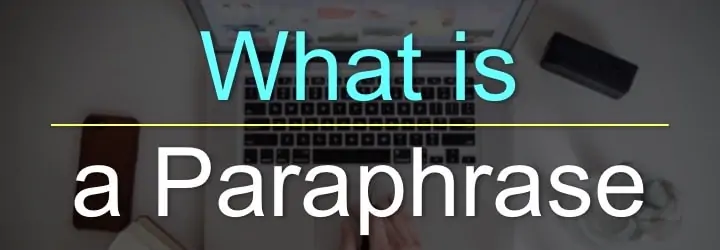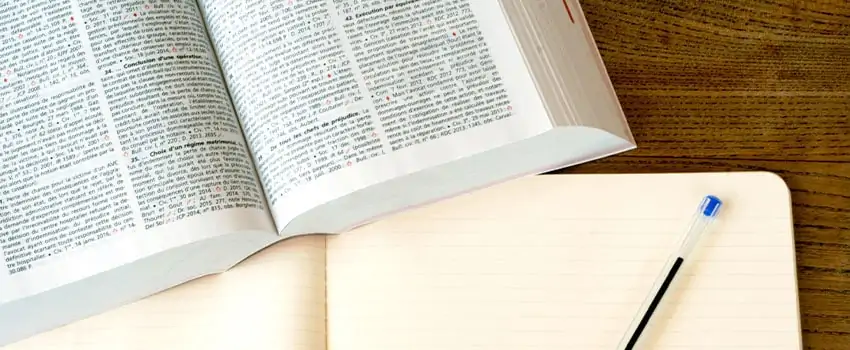One of the goals of a research project is to defend your argument or claim by using other sources as evidence. We do this when we argue or engage in a discussion with our friends; we backup our claims by including evidence from other sources, perhaps by sharing information from an article we’ve read or a show we’ve watched.
When creating a research project, we backup our claims in the same way. We either include exact lines of text or we paraphrase the information from other sources. This page focuses on how to effectively paraphrase information from other sources.
Before we get started, what is paraphrasing? Paraphrasing is the act of using another person’s information in your own project, but rewording it in a way that uses your own words and writing style.
Why Paraphrase?
Quotes are useful and great to use in a paper, but not as the sole content of the paper. Imagine filling a paper with nothing but quotes related to your topic. It’d be easy to do, but the paper would not include any of your own thoughts and your teacher may view the paper as lazy and not well written. On the other hand, with a paraphrase you put the information into your own words. This demonstrates that you’ve understood and critically considered information. In addition, it’s an opportunity for you to demonstrate your own thoughts on the topic.
Paraphrasing is also a useful way to concisely summarize information. Perhaps you loved a long passage but you don’t want to quote the entire thing in your paper. Solution: simply paraphrase it!
What it Looks Like
Let’s look at a direct quote, or exact line of text, from the famous children’s book, Charlie and the Chocolate Factory, by Roald Dahl:
Walking to school in the mornings, Charlie could see great slabs of chocolate piled up
high in the shop windows, and he would stop and stare and press his nose against the
glass, his mouth watering like mad. Many times a day, he would see other children taking creamy candy bars out of their pockets and munching them greedily, and that, of course, was pure torture (Dahl 8).
To paraphrase this properly, we need to reword it in a different way, using our own style of writing, while capturing the same meaning and essence of the movie quote.
Here’s an acceptable paraphrase for the paragraph from the book:
Poor Charlie would suffer as he watched his classmates enjoying chocolate bars and as
he passed the candy store, which was fully stocked with delicious treats (Dahl 8).
In the above example, we’re using the same concept and idea as the book’s text, but writing it in our own words.
What it’s Not
Paraphrasing is tricky because it requires us to read text, analyze it, and write it out in our own words and in our own style.
It is NOT acceptable to simply substitute the words in the text with synonyms.
Here’s an unacceptable paraphrase for the Charlie and the Chocolate Factory passage:
While strolling to class at daybreak, Charlie viewed giant pieces of chocolate stacked in the store’s windows. He would gaze at the chocolate and squeeze his nose to the window pane, drooling like crazy. On numerous occasions during the day, he’d view classmates pulling luscious chocolate bricks from their pockets and enjoy them immensely. It was awful for Charlie (Dahl 8).
This paraphrase is too similar to the original quote. It’s considered plagiarism!
How to Paraphrase
Follow these steps to paraphrase text from a source:
- Read the text from the original source and re-read it again to fully comprehend the author’s meaning.
- Put the information to the side and without looking at it, rewrite the information in your own words and in your own style.
- Glance at the original source again to make sure you have included the key concepts in your paraphrase.
- Even though you paraphrased the information in your own words, you still need to show that the information came from another source. You do this by creating an in-text citation and placing it after the paraphrase. You can see the in-text citations in the examples above. They are shown as (Dahl 14). The next section explains how to properly create and format an in-text citation.
How to Cite a Paraphrase
While getting into a heated debate with our friends, it’s always helpful to backup our argument with evidence from other sources, but what we generally do not do is share who the author of those sources are. That’s something that we must do with research projects. Depending on which citation style you choose to format your paper in, such as MLA format, APA format, or one of the hundreds of other styles available on BibMe, you have to include a couple of items about the source, directly after, or close to the paraphrase. This helps the reader understand that the text or information they read is coming from another source.
Here are the most common ways to cite a paraphrase in the body of your work:
MLA:
(Last name of the Author page number).
Example:
Here is my paraphrase (Dahl 8).
APA:
(Last name of the Author, year the source was published).
Example:
Here is my paraphrase (Dahl, 1998).
These in-text citations provide brief information about the source. If a reader wants to find more information about the exact source, they can head to the last page of the project and review the Works Cited list, Reference page, or bibliography. That’s where the reader can find the full citations, which tells more about the source.
Here’s the full citation in MLA:
Dahl, Roald. Charlie and the Chocolate Factory. Puffin Books, 1998.
Here’s the full citation in APA:
Dahl, R. (1998). Charlie and the Chocolate Factory. London, England: Puffin Books.


